Now You Know Recent Development of Simplex Machine
Friday, 8 March 2019
Edit
Recent Development of Simplex Machine
Golam Mawla
Daffodil International University
Department of Textile Engineering
Facebook: https://www.facebook.com/golammawlabd
Email: mawla3140@diu.edu.bd
Daffodil International University
Department of Textile Engineering
Facebook: https://www.facebook.com/golammawlabd
Email: mawla3140@diu.edu.bd
Introduction:
Simplex is an intermediate machine that used between the draw frame and the ring frame. The main purpose of this machine is to produce the roving package for the ring frame. The sliver that gets produced from the draw frame does not have the proper attenuation of fibers and twist. For this purposes simplex machine is used to produce perfect slivers that means roving for the ring frame. But this machine increases the production cost of the yarn. Among the machines of spinning sector simplex got the least development. But still this machine has been developed in several ways. These developments have been done without increasing the production cost of the yarn.
Simplex:
Simplex is the machine where the sliver is subjected to one or more attenuating process & the attenuated sliver receive a small amount of twist and is then wound on bobbins suitable for creeling at next process.
Objects of Simplex Machine:
- Attenuation of drawn sliver to form roving of required count by drafting.
- Insert small amount of twist to increase the roving strength.
- To wind the twisted roving on to the bobbin.
- To remove remaining trash from the drawn sliver.
- To produce a suitable roving for the next process or ring frame.
Among the machines of spinning mill developments of simplex have done the least. It adds the production cost of the yarn. But still several developments have done for the simplex.
Improved Drafting System:
Modern double-apron systems exist in 3 over 4 cylinder versions. The 4 cylinder version is usually operated with a low draft in the final drafting zone. This may slightly reduce roving hairiness. Only double apron arrangements enable drafts of 20 while holding the fibers more or less under control during their movements.
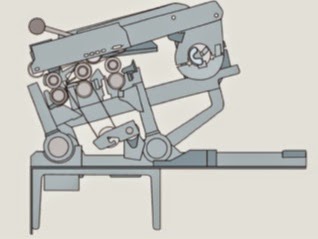 |
| Fig: 2. 3over 3 drafting system |
Earlier flyers were invariably made of steel, but they are now mostly made of light alloy. At the high speeds currently considered normal steel flyers would spread at the legs considerably. Modern flyer speed maximum 2000 rpm, 1000-1500 rpm is commonly used.
 |
| Fig: Flyer |
- Plastic Flyer: Plastic flyer is used in simplex machine that is lighter in weight.
- Top Mounted Flyer: The standard design of the flyer is the top-mounted flyer. Among other things, this form facilitates automation of the doffing operation. The flyer is supported by ball bearings at the neck and is driven by gear wheels or toothed belts from above.
Automatic doffing enables labor requirements and doffing times to be drastically reduced. This has been made possible by separate actuation of bobbin rail and doffer rail by two independent frequency converters.
 |
| Fig: Doffing Sequence |
Transporting individual roving bobbins manually from the simplex to the ring spinning machine is labor-intensive and often results in damage to the roving. For this problem roving bobbin transport system is available for bobbin transport from roving frame to ring spinning machine.
Quality:
- Elimination of manual bobbin handling.
- Elimination of intermediate storage, which can result in damage, soiling and aging of the roving.
- Elimination of the likelihood of confusion between different roving bobbins.
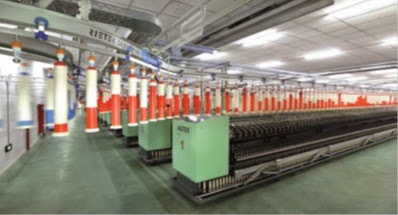 |
| Fig: Roving Bobbin Transport System |
- Space saving
- Labor savings of up to 25% compared to manual bobbin transport by reducing physical effort, reducing the distance covered by operating personnel.
Monitoring at the delivery of the drafting arrangement can also be performed by light barriers. In this case, the light beam is usually directed straight past the flyer tops. In the event of a roving break, the broken roving end whirls around the flyer top or so-called ‘hoods’ form at the flyer top. This interrupts the light beam and causes the machine to be stopped.
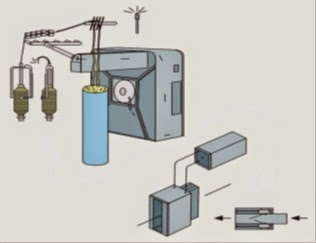 |
| Fig: Roving Stop Motion |
False twisters are used on the flyers to add false twist when the roving is being twisted between the front roller and the flyer. Because of this additional twist, the roving is strongly twisted and this reduces the breakage rate.
 |
| Fig: False Twister |
In multi-motor drive system, drafting rollers, flyers, bobbins and bobbin rail are driven directly by individual servomotors and are synchronized throughout package build by the control system. The advantages of this system are like, no need of heavy counter weight for bobbin rail balancing and differential gear, reduced maintenance, lower energy consumption, etc. All machine manufacturers incorporate four-motor-drive system except Toyota that uses three servomotors on simplex. One motor for drafting system and flyer while one motor each for bobbin drive and bobbin rail.
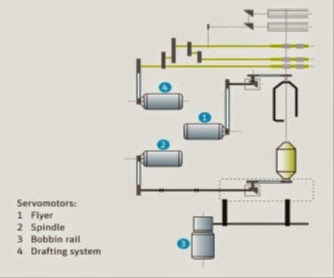 |
| Fig: Electronic driving system |
Machine stops automatically after a predetermined length of roving is wound on the bobbin.
Blower Apparatus:
Simplex not only produce a significant quantity of fly they also continually stir it up. This necessitates a corresponding effort to keep the installation clean. To relieve attendants at least partly of this burden, traveling blowers are now increasingly being used. These consist essentially of a powerful fan that moves back and forth on rails above the machines.
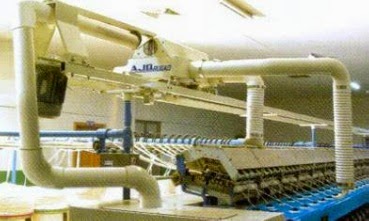 |
| Fig: Blowing & suction device |
For monitoring different measurements and production rate of the simplex there is a computerized monitor in simplex. It includes display button including main page, monitor, CCD, set, function, check, and shift output. It can display shift output, spindle speed of small, middle, big roving, location and variation of the moved parts, which realizing the conversation between man and machine.
 |
| Fig: A computerized monitor or simplex (WEIKU FA425A) |
High precise CCD sensor can check and measure automatically the statement of roving tension stochastically and feedback it to the computer for adjusting at any moment which make the roving tension keep the optimum value to all kinds of roving and create good condition to improve roving quality.
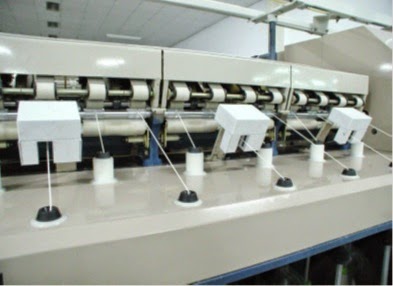 |
| Fig: CCD Sensors |
Several developments of the simplex have known from the report. The significant development has been done in the drafting system, winding system monitoring system and roving package transport system. The drafting system provides the required draft and the attenuation of fibers in roving. In the winding system flyers has been gotten the development etc. So, simplex frame plays an important role in the spinning process. Various types of yarn faults could be appear for the wrong drafting or twisting. For this reason, the operator should be careful during the process.
Though the simplex has got the least development but still it provides the perfect required roving package for the ring frame.
References:
- W. Klein, Manual of textile technology (volume 4), The Textile Institute, 2012-2013, Page No: 41-55
- http://www.slideshare.net/sheshir/simplex-comber-ringframe?qid=aed35c70-b1bf-4c4f-a40c-475e558c47a3&v=qf1&b=&from_search=7
- http://www.indiamart.com/spindraft/new-items.html
- http://www.weiku.com/products/9480537/FA425A_of_roving_frame.html
- http://sutex-china.en.alibaba.com/product/267105993-219217608/High_Speed_Roving_frame.html
- http://www.rieter.com/cz/rikipedia/articles/spinning-preparation/the-roving-frame/automation/doffing/automatic-doffing/
